In May of this year, I flew from San Francisco to Boston to celebrate the 80th birthday of Lia Gelin Poorvu ’56. Lia and I have been friends since the fall of 1953, when we both lived on the French corridor in Tower Court. Though I was a senior and she a sophomore, we bonded over our shared Francophilia and seeded a relationship that has flourished for more than 60 years.
Three years before, she had flown in the opposite direction for my 80th in Palo Alto. Another Wellesley friend, Phyllis Kyrides Lapham ’54, came from Dallas, and the three of us spent rich and poignant hours recalling our campus days when we hurriedly donned our jeans in the morning, rushed through breakfast, and barely made it to class with assignments completed late the night before.
We shared memories of attending weekend mixers where we tried our best to shine as attractive “well-rounded” young women; of visiting the Boston and Cambridge museums for projects related to Art 100; and of singing French songs in the Great Hall of Tower Court with Mademoiselle Dennis at the piano. Both Phyllis and Lia remembered my fiancé, Irv Yalom, as an overworked medical student during the year that led up to our marriage in June 1954. Since then, wherever I have lived—Massachusetts, New York, Maryland, Hawaii, California, France, England, and Austria—Phyllis and Lia have always been integral to my life.
During the past half-century, the stock in female friendship has been on the rise.
Most Wellesley women can tell similar stories. Since the College was founded, close friendships have been a mainstay of the Wellesley experience. According to Another Self, Linda W. Rosenzweig’s book on the lives of American women from 1880 to 1920, friendship was what many students most craved and valued in their college years, especially at same-sex institutions like Wellesley. She cites the letters written by a Wellesley student named Jane Cary to her mother during 1913 and 1914 that included vignettes of the classmates who made her life “fuller, richer, and happier.” Cary related her surprise in becoming close to a certain Helen, who took the initiative in “all the making friends part” and contributed significantly to her enjoyment of college life. Since men were rare on the Wellesley campus, there were all-female parties, where younger students routinely asked upperclasswomen to dance with them. The atmosphere was undoubtedly charged with the fierce emotions that young people feel toward each other, whether in heterosexual or same-sex circles.
According to Rosenzweig, professors encouraged their students to make friends carefully, with an eye to the intellectual and moral benefits derived from the “right” friends. A 1901 member of the Smith College faculty counseled students to form friendships inspired by lofty ideals and high culture. Comfort was to be found inside the college community, with its sense of sisterhood, rather than in a frenzied search for a man, or —perish the thought—“a premature love affair,” as another counselor put it.
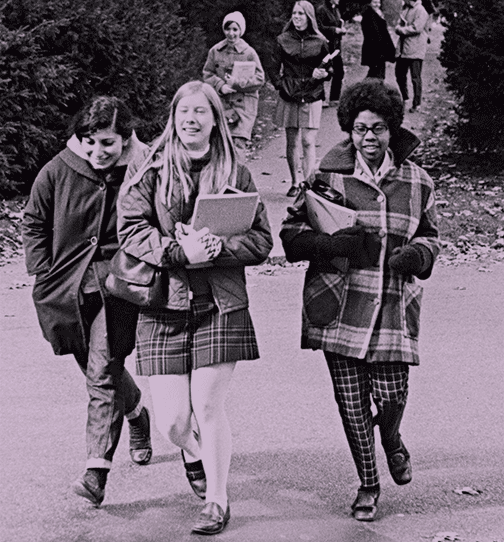
Plaid Brigade: students between classes in 1971.
Yet most Wellesleyites, like their sisters at Smith, Vassar, and other women’s colleges, married once their student days were over, and it was not always easy to maintain friendships in their new roles as wives and mothers. Centuries before, the English poet Katherine Philips (1631–64) had bluntly voiced the problem: “We may generally conclude the Marriage of a Friend to be the Funeral of a Friendship.” But Wellesley women in the early 20th century, as they do today, maintained contact with their friends long after the college years, as attested by their surviving letters and diaries. Without email, telephones, or airplanes, they counted on the postman for major news of births and deaths and all the other smaller incidents of daily life that we ache to share with our loved ones.
In our book, The Social Sex: A History of Female Friendship, Theresa Donovan Brown and I trace the evolution of women as friends from the Bible to the present, with special attention to the past 150 years. The so-called New Woman—a spunky, independent young figure featured prominently in advertisements, posters, and magazines at the turn of the 20th century—was drawn, in large part, from the first and second generations of “college girls” and “city girls” who began to enter the workforce in increasing numbers and who often counted on each other for both emotional and material sustenance.
It was common for unmarried working-class women to share lodgings and expenses as they sweated 10 hours a day, six days a week in the New York garment industry, and then went together on their day off to Luna Park in Brooklyn’s Coney Island or to one of the hundreds of movie houses in the city. After they married, they were sometimes able to leave paid employment and stay home to take care of their families, usually with the mutual assistance of other neighborhood moms. This description of an Irish family living in an Upper East Side tenement was probably typical: “Mrs. H. is very often in the house of Mrs. C., and they exchange many favors in the course of a day, while at night their husbands play cards and share the beer.”
Middle-class women with careers as secretaries, social workers, or teachers also lived together before marriage or as lifelong partners. In the 1920s, Greenwich Village was home to several professional female couples, including Esther Lape, a 1905 Wellesley graduate and college professor, and Elizabeth Read, a Smith graduate and attorney. Lape and Read have made their way into history as friends of Eleanor Roosevelt when Roosevelt was desperately in need of friends. In their Greenwich Village apartment, Roosevelt—by then the mother of five living children—shed the cloak of an aggrieved wife and dutiful daughter-in-law and became one of the girls, happy to dine informally and read poetry aloud. Historian Doris Kearns Goodwin credits Lape and Read, along with Marion Dickerman and Nancy Cook, with playing “a substantial role in the education of Eleanor Roosevelt, tutoring her in politics, strategy, and public policy, encouraging her to open up emotionally, building her sense of confidence and self-esteem.”
How to encourage a friend in her personal and professional development is something many of us learned for the first time at Wellesley. With luck, this aspect of the “Wellesley Effect” continues throughout a lifetime. My long-term Wellesley friends, Phyllis and Lia, have played important roles in helping me become the person I am today. Phyllis, a history of art major with an acute aesthetic sensibility, taught me how to accessorize my clothes and put on makeup when we were at Wellesley. Later, when she became a designer and antiques dealer, she helped me furnish my home, including the dining-room drapes that have now lasted for 40 years. Lia, who became a French professor as I did, started sending a barrage of books and articles early in our careers, and, within the last two decades, joined me in several outings to France. And no one has been more supportive of my publications than Lia: With every book she manages to arrange a speaking engagement for me in the Boston area or throw a book party in her lovely Cambridge apartment.
How to encourage a friend in her personal and professional development is something many of us learned for the first time at Wellesley. With luck, this aspect of the ‘Wellesley Effect’ continues throughout a lifetime.
Phyllis’s and Lia’s husbands also became part of my friendship circle. The late Roger Lapham introduced me to truffles at Lucas Carton in Paris, and when he and Phyllis lived in San Francisco, always made a seat available to me in their box at the opera. Bill Poorvu not only gives me advice on my writing (it was he who suggested I include Eleanor Roosevelt in my latest book), but has also become friends with my psychiatrist husband, Irv, my photographer son, Reid, and my daughter, Eve, an obstetrician gynecologist.
Throughout my adult life, my two Wellesley friends and I have commiserated with each other over countless personal problems including marital woes, worries about children and grandchildren, illnesses, and, most sadly, the death of Phyllis’s husband. There is virtually nothing I cannot discuss with them, if not in person, then by phone and email. Like many of the women interviewed for The Social Sex, I often tell myself: I’d never have made it without my friends.
Long before it was fashionable, Wellesley taught us to value other women. At a time when there were few female professors in academia, our professors embodied a heady mixture of intelligence and success, not to mention kindness and caring. I wanted to be just like them, with the additional joys of marriage and motherhood (little did I know just how difficult that combination would be). Along with biblical history and biology, we learned to trust our mentors and to depend upon our friends. Sure, there were incidents of cattiness and one-upwomanship, but these were rare in comparison to the overall friendly atmosphere that prevailed on campus and the individual acts of support that students proffered to each other. Wellesley women in the 1950s, like earlier cohorts, learned that “sisterhood is powerful” before those words had become a political slogan.
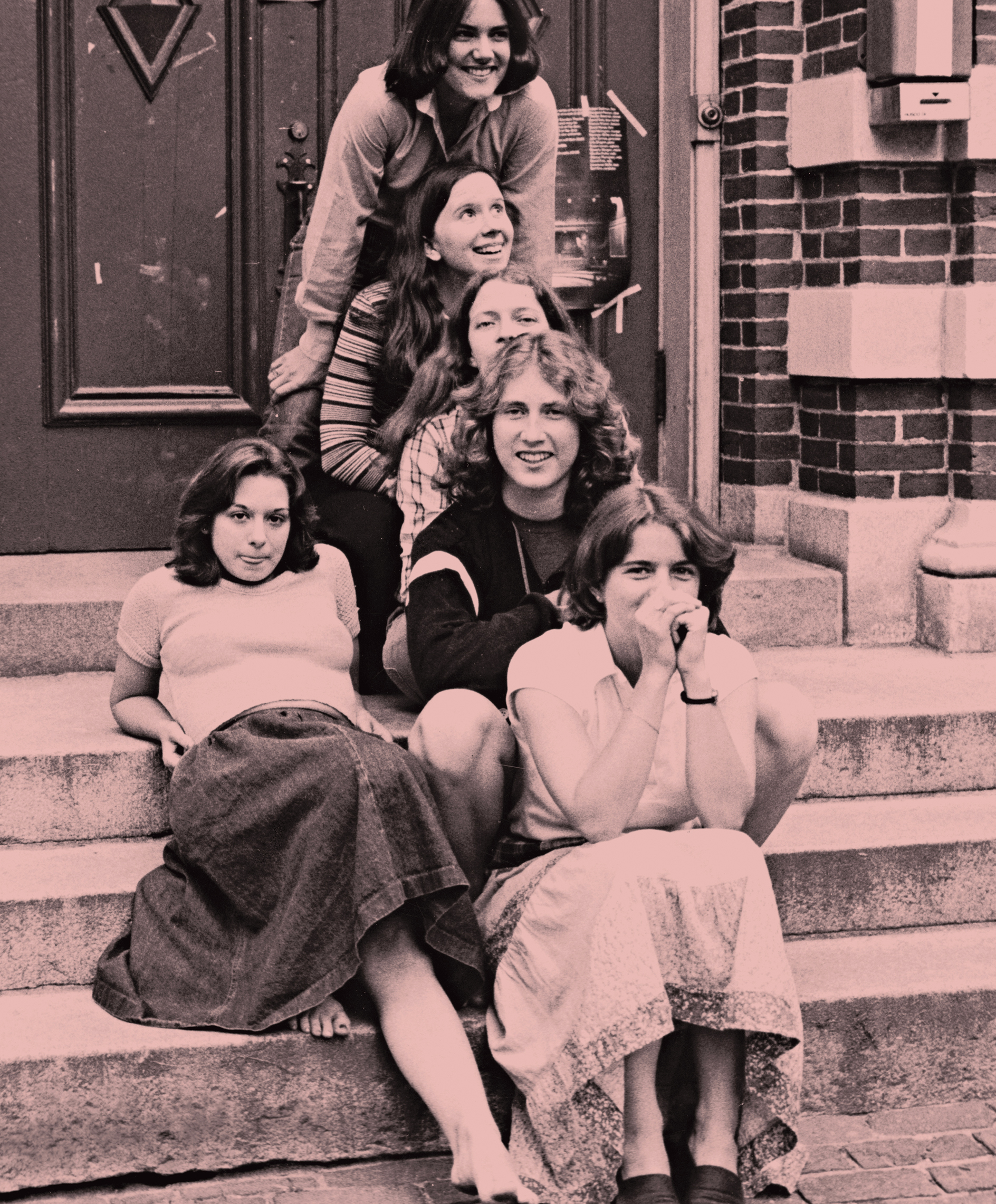
Stepping Out: students on the front steps of Beebe, date unknown.
During the past half-century, the stock in female friendship has been on the rise. Women’s interdependence has become increasingly visible because Americans marry later than their parents and grandparents, or do not marry at all, or find themselves single again after divorce or the loss of a partner. The strong bonds between contemporary women have helped attenuate past stereotypes, prevalent from Aristotle to Montaigne, that depicted women as jealous rivals incapable of the loyalty ascribed to men. If you ask an American today whether men or women have more friends, the answer will most likely be women, according to our informal poll and reading of popular literature. Indeed, the qualities of affection, self-disclosure, trust, and reciprocity associated with female friends are now increasingly sought after by both women and men.
As a women’s college, Wellesley will continue to promote strong bonds among its students, who will then carry a model of collaborative support into the world outside. What has proven fruitful on an interpersonal level may yet find its way into the boardroom, the legislature, and other branches of the public sphere as a further extension of the Wellesley Effect.
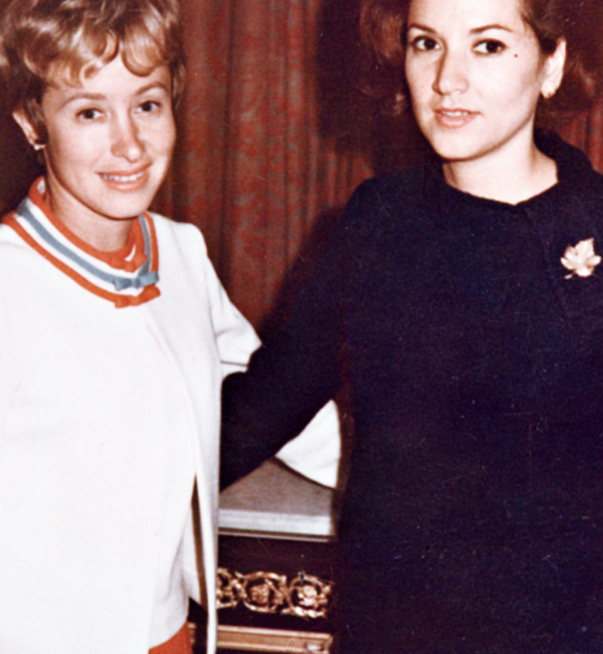
Marilyn Koenick Yalom ’54, a recipient of Wellesley’s 2013 Alumnae Achievement Award, is a feminist scholar, cultural historian, and writer. She is currently a senior scholar at the Clayman Institute for Gender Research at Stanford University. Her latest book, The Social Sex: A History of Female Friendship, was released by Harper Perennial in September.
All photos courtesy of Wellesley College Archives and © Bettmann/Corbis




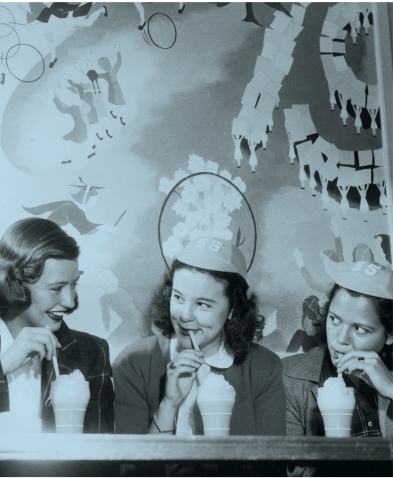




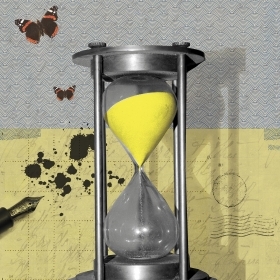
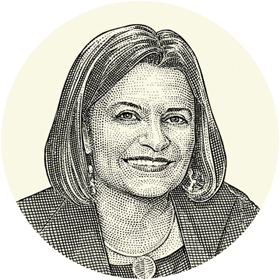
We ask that those who engage in Wellesley magazine's online community act with honesty, integrity, and respect. (Remember the honor code, alums?) We reserve the right to remove comments by impersonators or comments that are not civil and relevant to the subject at hand. By posting here, you are permitting Wellesley magazine to edit and republish your comment in all media. Please remember that all posts are public.